
R-Type is a horizontally scrolling shooter arcade video game developed and released by Irem in 1987 and the first game in the R-Type series. The player controls a star ship, the R-9 "Arrowhead", in its efforts to destroy the Bydo, a powerful alien race bent on wiping out all of mankind. The R-9 can acquire a glowing orbicular device called a "Force", protecting it from enemy fire and providing additional firepower. The arcade version was distributed by Nintendo in North America; it is the last arcade title Nintendo distributed.
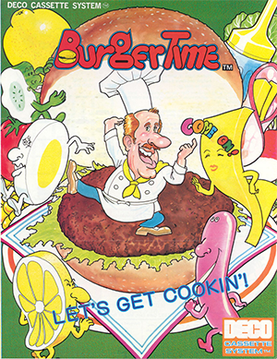
BurgerTime, originally released as Hamburger in Japan, is a 1982 arcade video game from Data East released initially for its DECO Cassette System. The player is chef Peter Pepper, who must walk over hamburger ingredients in a maze of platforms and ladders while avoiding anthropomorphic hot dogs, fried eggs, and pickles which are in pursuit.
A sports video game is a video game that simulates the practice of sports. Most sports have been recreated with video games, including team sports, track and field, extreme sports, and combat sports. Some games emphasize playing the sport, whilst others emphasize strategy and sport management. Some, such as Need for Speed, Arch Rivals and Punch-Out!!, satirize the sport for comic effect. This genre has been popular throughout the history of video games and is competitive, just like real-world sports. A number of game series feature the names and characteristics of real teams and players, and are updated annually to reflect real-world changes. The sports genre is one of the oldest genres in gaming history.
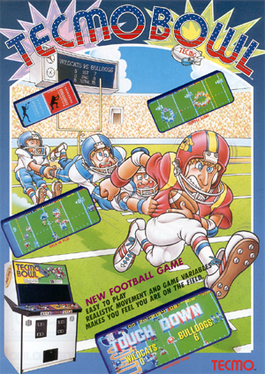
Tecmo Bowl is an American football video game developed and released by Tecmo. Originally released as an arcade game in 1987, the game features a large dual screen cabinet with up to four players between two fictitious teams. A port for the Nintendo Entertainment System was released in 1989 and was the first console game to include real National Football League players, via a license from the NFL Players Association. A Game Boy version developed by Sculptured Software followed in 1991. The NES version was extremely popular, spawning various sequels, starting with 1991's Tecmo Super Bowl. The NES original has been cited as one of the best sports video games ever made. The NES and arcade versions have been re-released for various platforms, including mobile phones, the Virtual Console, the NES Classic Edition, and Nintendo Switch.

Track & Field, also known as Hyper Olympic in Japan and Europe, is a 1983 Olympic-themed sports video game developed by Konami for arcades. The Japanese release sported an official license for the 1984 Summer Olympics. In Europe, the game was initially released under the Japanese title Hyper Olympic in 1983, before re-releasing under the US title Track & Field in early 1984.

Bad Dudes Vs. DragonNinja, also known simply as either Bad Dudes or DragonNinja, is a side-scrolling cooperative beat 'em up game developed and released by Data East for arcades in 1988. It was also ported to many computer and game console home systems.

Lode Runner is a 2D puzzle-platform game, developed by Doug Smith and published by Broderbund in 1983. Its gameplay mechanics are similar to Space Panic from 1980. The player controls a character who must collect all the gold pieces in a level and get to the end while being chased by a number of enemies. It is one of the first games to include a level editor.

The Nintendo VS. System is an arcade system developed and produced by Nintendo from 1984 to 1990. It is based on most of the same hardware as the Family Computer (Famicom), later released as the Nintendo Entertainment System (NES). Most of its games are conversions from the Famicom and NES, some heavily altered for the arcade format, and some debuted on the VS. System before being released on the Famicom or NES. The system focuses on two-player cooperative play. It was released in three different configurations: upright VS. UniSystem cabinets, upright VS. DualSystem cabinets, and sit-down VS. DualSystem cabinets. Games are on pluggable circuit boards, allowing for each side to have a different game.

Moon Patrol is a 1982 arcade video game developed and released by Irem. It was licensed to Williams for distribution in North America. The player controls a Moon buggy which can jump over and shoot obstacles on a horizontally scrolling landscape as well as shoot aerial attackers. Designed by Takashi Nishiyama, Moon Patrol is often credited with the introduction of full parallax scrolling in side-scrolling games. Cabinet art for the Williams version was done by Larry Day. Most of the home ports were from Atari, Inc., sometimes under the Atarisoft label.

Kung-Fu Master, known as Spartan X in Japan, is a side-scrolling beat 'em up game developed by Irem as an arcade game in 1984, and distributed by Data East in North America. Designed by Takashi Nishiyama, the game was based on Hong Kong martial arts films. It is a loose adaptation of the Jackie Chan, Sammo Hung, and Yuen Biao film Wheels on Meals (1984), called Spartan X in Japan, with the protagonist Thomas named after Jackie Chan's character in the film. The game is also heavily inspired by the Bruce Lee film Game of Death (1972), which was the basis for the game's concept. Nishiyama, who had previously designed the side-scrolling shooter Moon Patrol (1982), combined fighting elements with a shoot 'em up gameplay rhythm. Irem and Data East exported the game to the West without the Spartan X license.
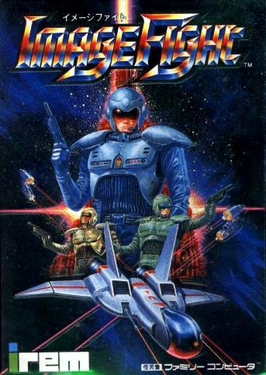
Image Fight is a 1988 vertically scrolling shooter arcade video game developed and published by Irem. It was ported to the Nintendo Entertainment System, PC Engine (Japan-only), Sharp X68000 (Japan-only), and FM Towns (Japan-only) in 1990.
1984 saw many sequels and prequels along with new titles such as 1942, Boulder Dash, Cobra Command, Jet Set Willy, Karate Champ, Kung-Fu Master, Yie Ar Kung-Fu and Punch-Out!! The year's highest-grossing arcade games were Pole Position in the United States, for the second year in a row, and Track & Field in the United Kingdom. The year's best-selling home system was Nintendo's Family Computer (Famicom), which was only sold in Japan at the time.

Spelunker is a 1983 platform video game developed by Timothy G. Martin of MicroGraphic Image. It is set in a colossal cave, with the player starting at the cave's entrance at the top, and the objective is to get to the treasure at the bottom.

Bump 'n' Jump is an overhead-view vehicular combat game developed by Data East and originally released in Japan as Burnin' Rubber. Distributed in North America by Bally Midway, the arcade version was available as both a dedicated board and as part of Data East's DECO Cassette System. The goal is to drive to the end of a course while knocking enemy vehicles into the sides of the track and jumping over large obstacles such as bodies of water.

Ninja Spirit, known in Japan as Saigo no Nindou, is a 1988 platform game developed and released in arcades by Irem. Although praised by gamers for detailed graphics, serious themes, solid controls and gameplay, the game also was criticized for its harsh difficulty.
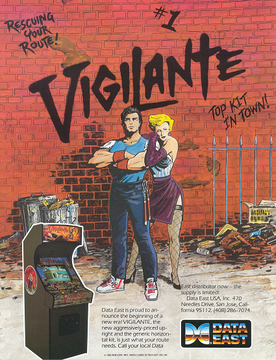
Vigilante (ビジランテ) is a 1988 beat 'em up arcade video game developed and published by Irem in Japan and Europe, and published in North America by Data East. It is considered as a spiritual sequel to Irem's earlier Kung-Fu Master (1984).

Touch Down Fever (タッチダウンフィーバー) is a 1987 American football arcade game developed and published by SNK. It was later ported to the NES and was released in North America by SNK in February 1991 and in Japan by K. Amusement Leasing on November 11, 1988, titled as Touch Down Fever: American Football.
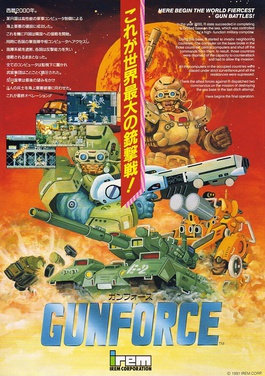
GunForce is a side-scrolling run and gun video game produced by Irem for arcades in 1991. The game was ported by Bits Studios and published by Irem for the Super Nintendo Entertainment System in 1992. The sequel, GunForce II, was originally known in Japan as Geo Storm.

Major Title is a golf sports video game that was released by Irem to arcades in 1990. A version of the game for the Super Nintendo Entertainment System as well as an arcade sequel, Major Title 2: Tournament Leader, were released in 1992. The SNES game and the arcade sequel were released in the United States as The Irem Skins Game.
Takashi Nishiyama, sometimes credited as "Piston" Takashi Nishiyama or T. Nishiyama, is a Japanese video game designer, director and producer who worked for Irem, Capcom and SNK before founding his own company Dimps. He is best known for developing Kung-Fu Master, Street Fighter, and Fatal Fury.

















